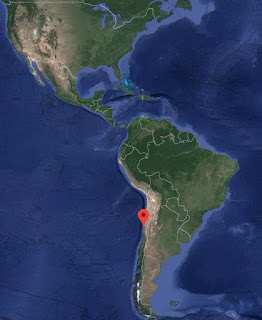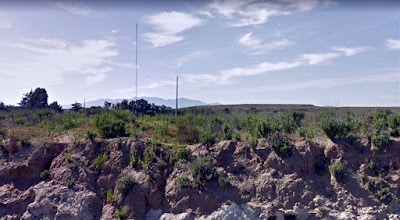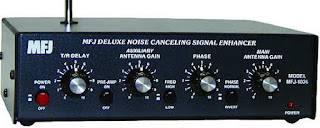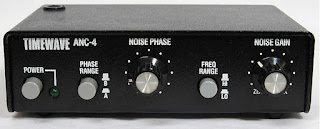Posts Tagged ‘MFJ-1026’
 CLE 228 Results
CLE 228 Results
 Last weekend's CLE yielded a mixed-bag of propagation. Friday night's conditions were the best of the three nights here in southwest B.C., but others found things a little different ... such are the vagaries of radio's magic.
Last weekend's CLE yielded a mixed-bag of propagation. Friday night's conditions were the best of the three nights here in southwest B.C., but others found things a little different ... such are the vagaries of radio's magic.All told, I logged 40 NDBs in the specified frequency ranges, with five of the logs being all time 'new catches'. After chasing NDBs regularly since the mid-80's, new ones do not come along too often. It's now fairly clear that as the Sun seriously starts to quiet down once again, propagation on the lower bands, especially the MF and LF part of the spectrum, is quickly improving ... a nice change over the past several years of continuous prop-killing geomagnetic activity during the downhill slide of Cycle 24. It looks as though things will be much better over the next several years as things get even quieter.
The highlight of the weekend was 'TOY' - 260kHz, from Tongoy, Chile. Although on the air for many years, this was the first time I have ever heard it ... on both Friday and Sunday evenings.
Located in coastal central Chile, 'TOY' runs some serious power at 3,000 watts. Along with its large vertical and rural location, I'm surprised I haven't heard it before.
 |
| Tongoy, Chile courtesy: https://www.google.ca/maps |
The nearby airstrip in seaside Tongoy is apparently no longer in service and the beacon appears to be an 'enroute' navigational beacon, similar to the high-powered ones in many unpopulated regions of northern Canada.
 |
| TOY-260 courtesy: https://www.google.ca/maps |
 |
| Tongoy Airstrip courtesy: https://www.google.ca/maps |
I have to wonder just how long beacons of this type will be useful enough to maintain as most aero navigation is now reliant on much more accurate GPS, RNAV and RNP systems ... time will tell, but NDBs appear to be going silent with increasing frequency throughout North America.
Another highlight was 500-watter 'QY'-263kHz, located in the heart of Sydney, Nova Scotia and not logged here since 2013. 'QY's large vertical appears to be located in a residential area, but perhaps the beacon was there long before the neighbours moved in. I'll put 'QY' into the receiver's memory as a good indicator of propagation to the east.
 |
| QY-263 Sydney, NS courtesy: https://www.google.ca/maps |
Logged using the Perseus SDR and inverted-L tuned to 300 kHz:
27 08:00 260.0 TOY Tongoy, CHL
27 08:00 260.0 ZXS Prince George, BC, CAN
27 08:00 260.0 YSQ Atlin, BC, CAN
27 06:00 260.0 MTH Marathon, FL, USA
27 06:00 260.0 JH Jackson, MS, USA
27 07:00 260.0 SNE Santa Elena, TX, USA
27 08:00 261.0 D6 Fairmont Hot Springs, BC, CAN
27 08:00 263.0 OAY Norton Bay, ALS
27 06:00 263.0 CVM Alton, IL, USA
27 10:00 263.0 3Z Russell, MB, CAN
27 07:00 263.0 BF Scottsbluff, NE, USA
27 06:00 263.0 QY Sydney, NS, CAN
27 10:00 263.0 YBB Kugaaruk, NU, CAN
27 07:00 263.0 ZQT Thunder Bay, ON, CAN
27 11:00 264.0 SZT Sandpoint Apt, ID, USA
27 08:00 264.0 ZPB Sachigo Lake, ON, CAN
27 10:00 266.0 ICK Annette Island, ALS
27 14:00 266.0 XD Edmonton, AB, CAN
27 14:00 266.0 VR Vancouver, BC, CAN
27 05:00 266.0 BZ Bozeman, MT, USA
27 08:00 266.0 GH Fort Good Hope, NT, CAN
27 07:00 266.0 SLE Salem, OR, USA
29 09:00 266.0 PYX Perryton Ochiltree Co Apt, TX, USA
27 05:00 268.0 ZWL Wollaston Lake, SK, CAN
27 05:00 269.0 YK Castlegar, BC, CAN
29 10:00 269.0 BEX Bloomfield, IA, USA
27 06:00 269.0 UDE Delta Station, MB, CAN
27 06:00 269.0 PK Park Rapids, MN, USA
27 14:00 269.0 ZW Teslin, YT, CAN
27 07:00 512.0 HMY Lexington, OK, USA
27 07:00 515.0 OS Columbus, OH, USA
27 06:00 515.0 PN Ponca City, OK, USA
27 07:00 515.0 CL Cresent Beach, WA, USA
27 05:00 516.0 YWA Petawawa, ON, CAN
27 07:00 521.0 ORC Orange City, IA, USA
27 05:00 524.0 MNL Valdez, ALS
27 05:00 524.0 HRD Hardin, TX, USA
27 07:00 525.0 ICW Nenana, ALS
27 05:00 529.0 SQM Sumner Strait, ALS
27 13:00 529.0 FDV Nome, ALS
The logs / reports from all participants may be viewed (once they have been posted) here on the NDB List website.
 MFJ / Timewave Noise Canceller Shootout
MFJ / Timewave Noise Canceller Shootout
A previous blog described a series of tests that Mark, VA7MM, performed demonstrating the effectiveness of his newly acquired MFJ- 1026 Noise Canceller.
He, along with Guy, VA7GI, recently had the opportunity to compare the performance of the MFJ against Guy's Timewave ANC-4.
I'll let Mark describe the results:
I'll let Mark describe the results:
NoiseCancellerShootout 2017 Report:
Guy Immega, VA7GI, and Mark Mattila, VA7MM, undertook side by side comparative tests of Timewave ANC-4 and MFJ-1026 noise cancellation gear (photos attached) by listening to interference at VA7MM in the HF spectrum between 7 MHz and 14 MHz. The program Spectran was used with the receiver on AM to adjust each unit for best performance and observe the relative performance of each. A system of coaxial relays was used to switch instantaneously between the units (photos attached).
Findings:
For practical purposes Timewave’s ANC-4 and MFJ’s 1026 are equal performers for eliminating interference in the HF spectrum.
Our findings corroborate the earlier findings of VE7CA that are posted on his website.
Switching the units in and out of noise was previously assessed on 40m CW, broadcast and raw noise. Examples of these tests are in a previous blogspot.
Commentary:
- main antenna in the tests was a multiband dipole at 30m above the ground.
- noise sense antenna was a Cushcraft R7 vertical antenna located 20m away from the main antenna.
- receiver was an Icom IC-746Pro.
- main antenna in the tests was a multiband dipole at 30m above the ground.
- noise sense antenna was a Cushcraft R7 vertical antenna located 20m away from the main antenna.
- receiver was an Icom IC-746Pro.
- both units tested have the same nulling capability.
- the preamp on the MFJ was found to be useful in certain instances for boosting the noise signal.
- in one test instance the Timewave unit produced intermod with AM broadcast leaking into the receiver when the noise gain was set near maximum.
- in instances where noise was coming from more than one direction, the filters could eliminate one noise source, or the other, but not both.
General Observations:
- the Timewave and MFJ filters have a learning curve to figure out how to quickly and precisely null out noise. A couple of evenings of tinkering was required to figure out how to use the unit with different noise sense antennas and different types of noise.
- the Timewave and MFJ filters have a learning curve to figure out how to quickly and precisely null out noise. A couple of evenings of tinkering was required to figure out how to use the unit with different noise sense antennas and different types of noise.
- the noise sense antenna is critical and must pick up a strong noise signal for the units to work effectively. In most instances for local interference at VA7MM the noise sense antenna is near the ground and vertically polarized and the main antenna is high above the ground and horizontally polarized.
- both noise amplitude and phase need to be alternately adjusted to attain a good null on the units.
- using Spectran or SDR with the receiver on AM helps in adjusting the units.
Next Steps:
- discussions are on combining the noise canceller with a small vertical plane receive loop on 160 or 80m. The idea is that the combination of the two could enable noise in two directions to be nulled. The receive loop would be pre-amplified.
- having two noise cancellers in series was also discussed as a means of nulling noise from two directions. An issue with this approach is that more processing electronics are put ahead of the front end of the receiver and this introduces its own noise and may create intermodulation.
- having two noise cancellers in series was also discussed as a means of nulling noise from two directions. An issue with this approach is that more processing electronics are put ahead of the front end of the receiver and this introduces its own noise and may create intermodulation.
- I like that the MFJ unit has gain controls for both the noise antenna and the main antenna. Other differences include MFJ providing both relay and RF sense T/R switching whereas the Timewave only has RF sense capability. The noise antenna connector on the MFJ is an SO-239which I find more practical than the RCA phono socket on the Timewave. As far as mechanical construction is concerned, the Timewave is more robustly built.
We’re open to any questions on these findings.
We’re open to any questions on these findings.
73,
Mark Mattila, VA7MM
Guy Immega, VA7GI
 MFJ / Timewave Noise Canceller Shootout
MFJ / Timewave Noise Canceller Shootout
A previous blog described a series of tests that Mark, VA7MM, performed demonstrating the effectiveness of his newly acquired MFJ- 1026 Noise Canceller.
He, along with Guy, VA7GI, recently had the opportunity to compare the performance of the MFJ against Guy's Timewave ANC-4.
I'll let Mark describe the results:
I'll let Mark describe the results:
NoiseCancellerShootout 2017 Report:
Guy Immega, VA7GI, and Mark Mattila, VA7MM, undertook side by side comparative tests of Timewave ANC-4 and MFJ-1026 noise cancellation gear (photos attached) by listening to interference at VA7MM in the HF spectrum between 7 MHz and 14 MHz. The program Spectran was used with the receiver on AM to adjust each unit for best performance and observe the relative performance of each. A system of coaxial relays was used to switch instantaneously between the units (photos attached).
Findings:
For practical purposes Timewave’s ANC-4 and MFJ’s 1026 are equal performers for eliminating interference in the HF spectrum.
Our findings corroborate the earlier findings of VE7CA that are posted on his website.
Switching the units in and out of noise was previously assessed on 40m CW, broadcast and raw noise. Examples of these tests are in a previous blogspot.
Commentary:
- main antenna in the tests was a multiband dipole at 30m above the ground.
- noise sense antenna was a Cushcraft R7 vertical antenna located 20m away from the main antenna.
- receiver was an Icom IC-746Pro.
- main antenna in the tests was a multiband dipole at 30m above the ground.
- noise sense antenna was a Cushcraft R7 vertical antenna located 20m away from the main antenna.
- receiver was an Icom IC-746Pro.
- both units tested have the same nulling capability.
- the preamp on the MFJ was found to be useful in certain instances for boosting the noise signal.
- in one test instance the Timewave unit produced intermod with AM broadcast leaking into the receiver when the noise gain was set near maximum.
- in instances where noise was coming from more than one direction, the filters could eliminate one noise source, or the other, but not both.
General Observations:
- the Timewave and MFJ filters have a learning curve to figure out how to quickly and precisely null out noise. A couple of evenings of tinkering was required to figure out how to use the unit with different noise sense antennas and different types of noise.
- the Timewave and MFJ filters have a learning curve to figure out how to quickly and precisely null out noise. A couple of evenings of tinkering was required to figure out how to use the unit with different noise sense antennas and different types of noise.
- the noise sense antenna is critical and must pick up a strong noise signal for the units to work effectively. In most instances for local interference at VA7MM the noise sense antenna is near the ground and vertically polarized and the main antenna is high above the ground and horizontally polarized.
- both noise amplitude and phase need to be alternately adjusted to attain a good null on the units.
- using Spectran or SDR with the receiver on AM helps in adjusting the units.
Next Steps:
- discussions are on combining the noise canceller with a small vertical plane receive loop on 160 or 80m. The idea is that the combination of the two could enable noise in two directions to be nulled. The receive loop would be pre-amplified.
- having two noise cancellers in series was also discussed as a means of nulling noise from two directions. An issue with this approach is that more processing electronics are put ahead of the front end of the receiver and this introduces its own noise and may create intermodulation.
- having two noise cancellers in series was also discussed as a means of nulling noise from two directions. An issue with this approach is that more processing electronics are put ahead of the front end of the receiver and this introduces its own noise and may create intermodulation.
- I like that the MFJ unit has gain controls for both the noise antenna and the main antenna. Other differences include MFJ providing both relay and RF sense T/R switching whereas the Timewave only has RF sense capability. The noise antenna connector on the MFJ is an SO-239which I find more practical than the RCA phono socket on the Timewave. As far as mechanical construction is concerned, the Timewave is more robustly built.
We’re open to any questions on these findings.
We’re open to any questions on these findings.
73,
Mark Mattila, VA7MM
Guy Immega, VA7GI
 MFJ-1026 Noise Canceller Tests At VA7MM
MFJ-1026 Noise Canceller Tests At VA7MM
 |
| courtesy: www.mfjenterprises.com/ |
Mark, VA7MM, has been testing out his newly-acquired MFJ-1026 Noise Canceller and has provided several videos of the noise canceller in action.
Like so many other hams, Mark's suburban location has seen a gradually rising noise floor and the noise heard in this video is from an off-site location within his local neighbourhood, located about 400m away.
The noise canceller requires a separate 'noise antenna' in order to cancel any noise on the main receiving antenna and for all of the tests shown below, Mark's noise antenna was a Cushcraft R-7 vertical while using an Icom IC-7600 transceiver for listening.
Test 1 shows the noise canceller being used while listening to a broadcast station on 6.0 MHz:
Test 2 shows the canceller's effect on raw noise while viewing in Spectran:
Test 3 shows the canceller's effect on a 40m CW signal:
Test 4 shows the effect of just the IC-7600's noise blanker on the offending noise:
Mark's comments:
Living in the noise cloud one must resort to special measures to use affected portions of spectrum. I recently purchased an MFJ-1026 noise canceller and have been testing the unit and have attached videos demonstrating the unit’s performance. You will see examples of raw noise, SW broadcast and 40 m CW signals with the unit being switched in and out. Also for comparison is the noise blanker in the IC-7600 failing to eliminate the same noise.
Conclusions:
- the unit is able to eliminate noise in most instances when adjusted properly
- the noise sense antenna is critical and several different switchable noise sense antennas may be required for good performance
- setting up on AM mode with Spectran helps with fine adjustment
- it outperforms the radio’s noise blanker in all cases tested
With proper tuning and set up, it looks like the MFJ-1026 can make a worthwhile improvement in unwanted noise reduction. Mark will also be testing and comparing a Timewave ANC-4 Noise Canceller with the MFJ and any videos received will be published here.
 MFJ-1026 Noise Canceller Tests At VA7MM
MFJ-1026 Noise Canceller Tests At VA7MM
 |
| courtesy: www.mfjenterprises.com/ |
Mark, VA7MM, has been testing out his newly-acquired MFJ-1026 Noise Canceller and has provided several videos of the noise canceller in action.
Like so many other hams, Mark's suburban location has seen a gradually rising noise floor and the noise heard in this video is from an off-site location within his local neighbourhood, located about 400m away.
The noise canceller requires a separate 'noise antenna' in order to cancel any noise on the main receiving antenna and for all of the tests shown below, Mark's noise antenna was a Cushcraft R-7 vertical while using an Icom IC-7600 transceiver for listening.
Test 1 shows the noise canceller being used while listening to a broadcast station on 6.0 MHz:
Test 2 shows the canceller's effect on raw noise while viewing in Spectran:
Test 3 shows the canceller's effect on a 40m CW signal:
Test 4 shows the effect of just the IC-7600's noise blanker on the offending noise:
Mark's comments:
Living in the noise cloud one must resort to special measures to use affected portions of spectrum. I recently purchased an MFJ-1026 noise canceller and have been testing the unit and have attached videos demonstrating the unit’s performance. You will see examples of raw noise, SW broadcast and 40 m CW signals with the unit being switched in and out. Also for comparison is the noise blanker in the IC-7600 failing to eliminate the same noise.
Conclusions:
- the unit is able to eliminate noise in most instances when adjusted properly
- the noise sense antenna is critical and several different switchable noise sense antennas may be required for good performance
- setting up on AM mode with Spectran helps with fine adjustment
- it outperforms the radio’s noise blanker in all cases tested
With proper tuning and set up, it looks like the MFJ-1026 can make a worthwhile improvement in unwanted noise reduction. Mark will also be testing and comparing a Timewave ANC-4 Noise Canceller with the MFJ and any videos received will be published here.
















